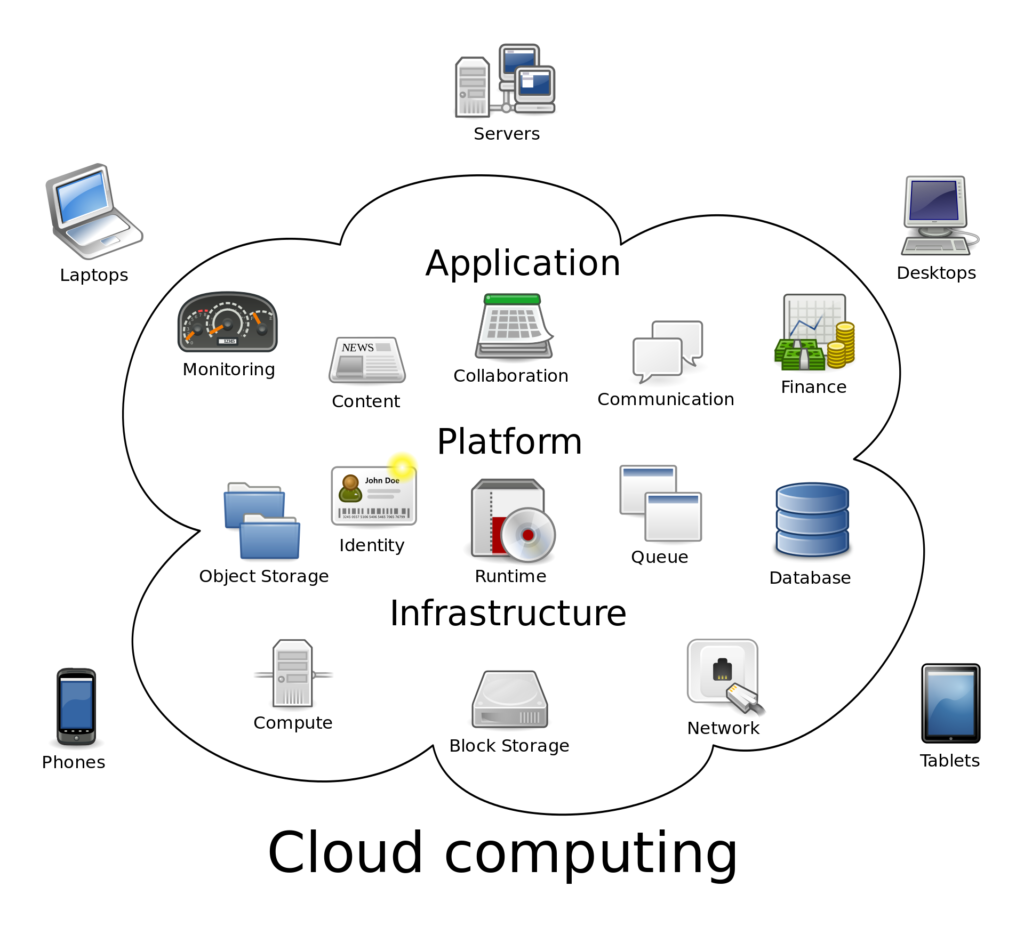So what is cloud computing anyway? Let us look at a cloud computing definition.

the practice of using a network of remote servers hosted on the Internet to store, manage, and process data, rather than a local server or a personal computer.
Dictionary
And for another cloud computing definition, let’s turn to ‘WhatIs.com’
Cloud computing is a general term for anything that involves delivering hosted services over the Internet. These services are broadly divided into three categories: Infrastructure-as-a-Service (IaaS), Platform-as-a-Service (PaaS) and Software-as-a-Service (SaaS). The name cloud computing was inspired by the cloud symbol that’s often used to represent the Internet in flowcharts and diagrams.
Whatis.com
So armed with these high level definitions, let’s get into some Acronyms:
- IaaS – Infrastructure as a Service
- PaaS – Platform as a Service
- SaaS – Software as a Service
- Private Cloud – your own premise/data centre
- Public Cloud – open internet service (Amazon Web Services)
- Hybrid Cloud – a mix of public and private
IaaS – Infrastructure as a Service
The lowest level of abstraction from the actual hardware, storage and networking. Handles the virtualisation of the hardware and services provided to the next layer and leaves you pretty much with the Operating system ready to go. Amazon Web Services and Microsoft Azure and examples of IaaS.
PaaS – Platform as a Service
The next layer up from IaaS is PaaS and typically used by Developers to be able to build software without having to worry about the underlying storage, operating systems, software updates or infrastructure. Google App Engine and Heroku are examples of PaaS implementations.
SaaS – Software as a Service
The top of the stack in terms of layers, SaaS sits on top of IaaS which sits on tops of SaaS. The software as a service layer can also termed cloud application services and leaves you to worry only about the application you are using, everything else is managed in the cloud. If you have used Google Apps or Dropbox then these are SaaS implementations. A number of organisations are driving their ERP transformations towards SaaS in public cloud.
Private Cloud
This type of cloud in effect is a closed box with only access to services available to your organisation or business. The benefits of cloud computing are similar albeit limited as you ‘own’ the infrastructure, networking, storage, software and therefore still have to manage the implementation and support.
Public Cloud
The public cloud is what you use when you access Google Apps where the entire solution is managed by a third party with no input by you in any of the management of the network, storage, operating system or infrastructure.
The services are offered to the wider public and accessible across the open internet.
The Public Cloud implementation offers the most advantages of 3rd party management, scale and cost advantages.
Hybrid Cloud
The hybrid cloud is a mix of public and private cloud implementations. This works well where some applications can be open and utilised on the large scale infrastructure. Utilising services over the public internet but some still require the privacy or security of the private or even on-premise solution.
Cloud Computing vs Traditional Computing
The traditional computing model is considerably different to the cloud computing model.
- Distributed – the cloud computing vs traditional computing model is less constrained. Cloud having a more distributed approach with servers in different geographic locations, but able to operate as if next together as in the traditional computing model. This provides greater resilience to the solution.
- On-Demand – the scale of cloud computing models makes them able to offer services ‘on-demand’ with infrastructure able to scale up or down ‘virtually’ to cope with peaks and troughs. Cloud computing vs traditional computing has a key advantage simply due to its distributed capability across geography and service providers.
- Charging – the traditional computing model has to be paid for in full, the infrastructure, hardware, storage, networking, software, everything. In the Cloud Computing model the cost can be cheaper as you pay for fractions of the cost of the infrastructure and solution and only for what you use (on-demand or utility charging).
- Management – traditional computing required that you managed the whole solution yourself. Leading to costly and complex service management with resource management of scarce skilled people. The cloud computing model enables the ‘provider’ to manage everything and you just consume the services.
There are occasions where an on-premise solution is more attractive due to security or privacy constraints as in Government or High Security organisations. But by and large some form of cloud computing is used by most large organisations today.
And bearing in mind that we all as consumers are utilising cloud services everytime we access our smart phones.
